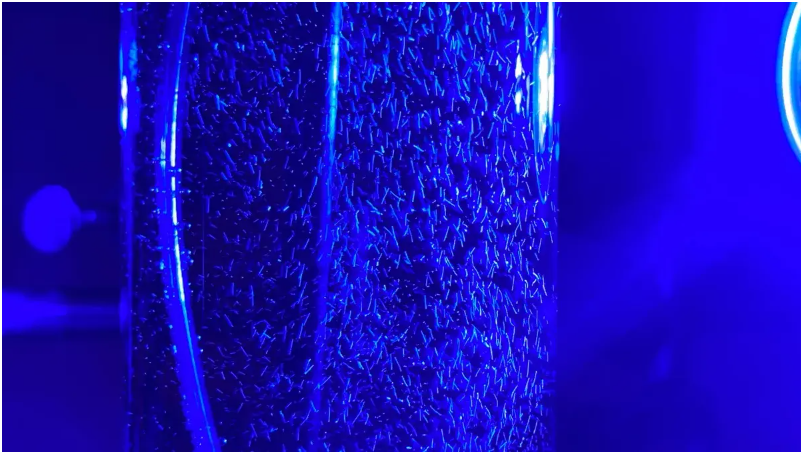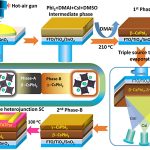New Iridium has introduced an innovative approach that employs photons, or light particles, instead of heat to drive chemical reactions. This groundbreaking technique not only opens doors to eco-friendly materials like ethanol from corn or sugarcane but also offers the potential to convert CO2 emissions from smokestacks into valuable chemicals. Utilizing Light Carbon Dioxide and Convert it into Valuable Products.
Pioneering Sustainable Chemistry
Traditionally, the chemical industry relies on energy-intensive methods such as steam cracking, a process that involves heating hydrocarbons derived from petroleum with steam to temperatures exceeding 850°C. While this method yields essential products like ethylene, it comes at a significant environmental cost, contributing over 2 billion metric tonnes of CO2 annually to global emissions. Utilizing Light Carbon Dioxide and Convert it into Valuable Products. Moreover, many chemical production processes depend on expensive and rare metals like platinum, palladium, and ruthenium as catalysts, some of which can be toxic.
New Iridium has come up with a new way to make chemicals that uses light particles called photons instead of heat to make them react. This could be a good way to solve problems with both the environment and resources in chemical production. They have recently secured a $1 million National Science Foundation (NSF) Small Business Innovation Research (SBIR) Phase II grant to further develop this technology.

Exploring Photocatalysis for Sustainable Chemistry
Photocatalysis, the core of New Iridium’s technology, utilizes light, such as that from LED lamps, instead of heat to activate and drive chemical reactions. This innovative approach not only offers a more environmentally friendly alternative but also the potential to capture CO2 and transform it into valuable, enduring products, making a significant contribution to greenhouse gas reduction.
Unlike traditional practices that rely on fossil fuels for heat, photocatalysis operates solely on electricity, enabling the utilization of renewable energy sources. New Iridium’s solutions are not only more energy-efficient and less carbon-intensive but also more cost-effective than traditional methods, with the potential for gigaton-scale CO2 abatement.
Targeted Chemical Processes
New Iridium is actively engaged in two key chemical processes. The first focuses on producing olefins, including ethylene, propylene, and butylene, which are fundamental components for plastics production. The second process aims to manufacture various chemicals like acetic acid, acrylic acid, methacrylic acid, and terephthalic acid, all with diverse applications in industries ranging from paint to electronics.
What sets this technology apart is its dual capability to capture CO2 and convert it into valuable, long-lasting products, making a substantial contribution to reducing greenhouse gas emissions.
Plant-Based Acetic Acid from Bio-Ethanol
Plant-based materials play a pivotal role in addressing climate change and transitioning from fossil fuels to renewable energy sources. One such material is bio-ethanol, primarily derived from corn and sugarcane and used primarily as a fuel additive.
As the demand for bio-ethanol decreases with the rise of electric vehicles, there’s an opportunity to repurpose it into raw materials for the creation of other plant-based chemicals and materials, reducing the environmental footprint of the chemical industry. New Iridium is developing a process to efficiently convert bio-ethanol into acetic acid, a valuable chemical with a substantial global market worth $15 billion in various industrial applications.
New Iridium’s plant-based acetic acid can significantly contribute to the decarbonization of products like EVA (poly(ethylene-vinyl acetate), a material used in items such as shoes. Using this plant-based acetic acid to make vinyl acetate can add up to 20% bio-content to EVA with only a small 5% cost increase. This makes it a sustainable and cost-effective choice for brands that care about the environment.
Energy Efficiency and Streamlined Production
Photocatalysis technology significantly reduces energy expenses by operating at room temperature rather than the extremely high temperatures required by traditional methods. It streamlines the production process for specific chemicals, reducing energy-intensive steps.
For instance, New Iridium’s CO2-to-chemical solutions require just two steps to produce the final product, compared to five steps in conventional methods. Photocatalysis harnesses light efficiently, making it a powerful tool for initiating chemical reactions without the need for extreme temperatures, resulting in a more efficient and environmentally friendly process.
Scaling Up for a Sustainable Future
New Iridium is currently conducting lab experiments and preparing for a significant transition. They are in the process of scaling up their operations with a 10-ton-per-year photoreactor and a “mini plant” setup. This mini plant is a downsized version of a full-scale chemical plant designed to operate continuously and validate the system’s functionality.
The key component of their setup is the photoreactor, equipped with LED lighting to ensure efficient light exposure while minimizing energy wastage. The final design for the reactor is still under consideration, exploring traditional and newer continuous flow designs for chemical production.
New Iridium’s pioneering approach offers a sustainable and environmentally friendly solution to address the challenges of traditional chemical manufacturing while significantly contributing to CO2 reduction and resource efficiency.
For further information follow this link: https://www.sciencedirect.com/science/article/abs/pii/S0301479719317773
Read our previous articles: https://scitechupdate.com/index.php/zinc-should-get-from-food-not-supplements/
https://scitechupdate.com/index.php/three-nobel-prizes-try-to-cover-all-of-science/
https://scitechupdate.com/index.php/the-most-populated-cities-in-the-world/
https://scitechupdate.com/index.php/aromas-and-odors-decoding-the-insect-brains-interpretation/
https://scitechupdate.com/index.php/pig-kidney-xenotransplantation-is-thriving-in-human-body/
https://scitechupdate.com/index.php/huaweis-new-smartphone-challenger-to-apple/
https://scitechupdate.com/index.php/israel-advances-cancer-treatment-with-genomic-profiling/https://scitechupdate.com/index.php/stomach-cancer-causes-signs-and-treatment/
https://scitechupdate.com/index.php/james-webb-telescope-captures-newborn-sun-like-star/
https://scitechupdate.com/index.php/oxygen-28-unstable-magic-isotope-that-defies-expectations/

